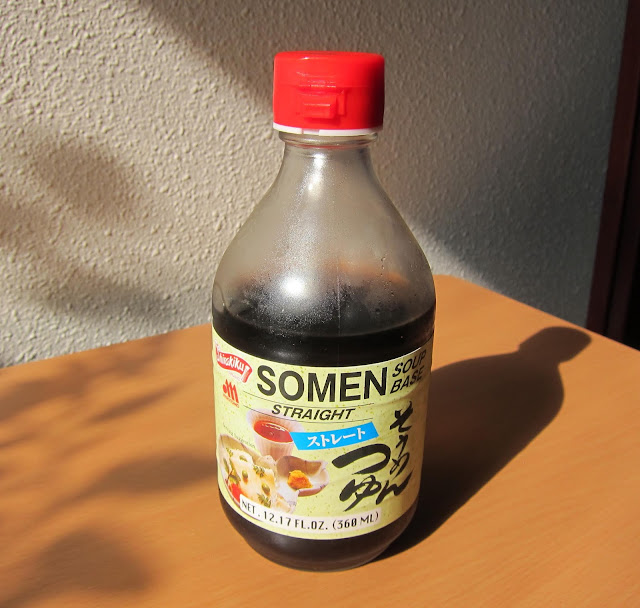Summer is over and there may not be a lot that we have to look back on, in a friendly way, but there was one thing we were able to enjoy and share in. That was enjoying the Mana in Yukata making negashi somen video. And while most of us do not have a somen noodle slide, it was still possible to make and enjoy cold somen during the hot summer days.
Chilled somen is not difficult to make, and Mana showed how to make excellent eggs to go with it. So what I am going to share in this blog is a little information about the dipping sauce tsuyu or mentsuyu.
There are a lot of recipes on the internet, with various ingredients and amounts of how much to put in. So I will share a little bit about the ingredients that can be used. Since they are basic staples for Japanese cooking, it is worth trying to find them. The first staple is sake. You could use regular sake, but it is nice to have a bottle of cooking sake on hand. Cooking sake tends to have less alcohol but also have salt which regular sake does not have.
Something that works in place of sugar or with it is the second staple, mirin. While sugar could be substituted, I find mirin has a nice distinctive flavor that is found in so much Japanese food. It is also a rice wine like sake, but with a higher sugar content. Like all of the ingredients, there are many good brands, but I prefer a glass bottle because the top closes better.
The third staple is soy sauce or shoyu. So many varieties out there! What I have right now in this photo left to right is a special shoyu from Hokkaido, tamari, usukuchi light color shoyu, and less salt shoyu.
I use the Hokkaido shoyu for sashimi and sushi dipping and other dishes where shoyu is a stand-alone ingredient. While somen isn't a gluten free dish unless gluten free noodles are used., tamari can still be used to make gluten free sauces. Usukuchi is sometimes used in some Japanese dishes. I find less salt or reduced sodium shoyu is good not just for health reasons, but also for taste. It is up to each person as to what they want to use. I do think it is worth it to try different shoyu, because there can be differences in flavor.
The fourth staple of Japanese cooking is dashi. Again, there are a lot of recipes online and just as many varieties of dashi. Basic dashi consists of three things. Water, konbu and katsuobushi. Konbu is a dried seaweed. It is thick and for cooking you can buy it in large pieces and cut off as much as you need. Konbu is used in various ways so it's worth searching for it to have in the kitchen. You can even use it in non-Japanese cooking. Add to a broth or sauce or rice for additional umami. Finely shredded konbu can be used as a topping for okonomiyaki and rice.
As for katsuobushi, that also comes in various forms. Katsuobushi is dried smoked bonita, a skipjack tuna. In Japan, some cooks have it in blocks which they shave with a katsuobushi kezuriki. While it helps to use larger pieces for making dashi, outside of Japan it's the smaller shavings that are usually in stores. These also work, just a little harder to remove from the dashi broth.
While dashi does take time and effort to make, it is definitely worth having. An easier way is to find instant dashi. Which also comes in a lot of varieties. If you want basic dashi stock, there is instant dashi for that. There is also dashi that can be used for making ramen, like the anchovy iroko dashi. Another instant dashi that I like is the Shimaya tennen dashi. As you can see, it also has shiitake mushrooms and anchovies in it. I use these and also make dashi, depending on the dish.
Of course, there is another way to have tsuyu. You can buy it premade. I do think it's fun to make dishes from scratch, but sometimes it's not possible to find all the ingredients or there isn't enough time cook it. So nothing wrong with using good premade items.
I hope you enjoyed my blog post. Here is the Moi-même-Moitié video of gothic elegant Chef Mana making somen noodles.









No comments:
Post a Comment